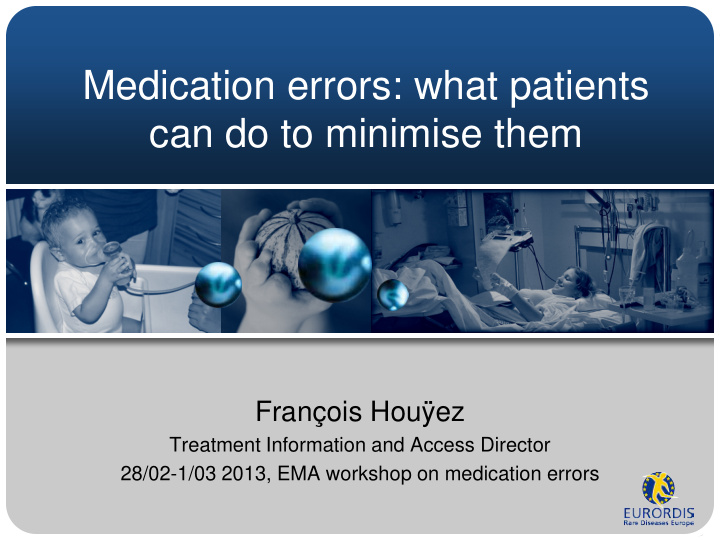



Medication errors: what patients can do to minimise them François Houÿez Treatment Information and Access Director 28/02-1/03 2013, EMA workshop on medication errors
Disclaimer Medicines mentioned in this presentation are for illustration purposes only, without any positive or negative opinion on the product itself, or on the marketing authorisation holder. 2
5 “R” rules Right drug (41,8%)* Right dose (35%) Right route (9,7%) Right time (0,9%) Right patient (1,5%) * Indicates error type in Guichet Erreurs Médicamenteuses: Présentation et bilan depuis la mise en place - Juin 2009 Affsaps (now ANSM) 3
Self-medication can be erroneous Istotretinoin to treat acne Thalidomide to treat severe aphtosis Women at risk of using product without proper information ? Do we always educate people never to share medicines with others? 4
Always read the notice! Always keep 1. Respect indication, don’t pills inside share with others their box! 2. Don’t take if contra- indicated 3. Be aware of situations that change terms of use 4. Adapt lifestyle 5. Respect dose, intake frequency, treatment duration, timing… 6. Contact HCP if ADR 7. Always be vigilant 5
In one’s medicine cabinet Two adults, one cabinet: each adult often takes the wrong tablet as both packs are kept together and look alike 6
Loose pills: which is what? ? What time? With or without food? Etc. 7
Sites that can help 8
Result 9
Or 10
A patient says • I take up to 80 mg a day depending on symptoms • The tablets come in various dose amounts • I used to take two or three 5 mgs a day now I take 1 mg 3 times a day • The blister packs that the medication is contained within are identical even the colour and you have to look carefully at the packet to see which dose it is • If you are vision-impaired it is more of a problem and you can easily take the wrong tablet • When you use them and pop a tablet out then it is harder to distinguish what the writing on the Why not a tablet-free zone? blister pack says as it has been broken up 11
Graphic design and Company corporate identity Contains: Contains: – Zidovudine – Zidovudine – Lamivudine – Lamivudine – Abacavir: 8% risk of potentially life-threatening hypersensitivity reaction. Never re-challenge 12
Graphic design and Company corporate identity http://www.thebody.com/content/art40466.html 13
Inconsistent choices Combivir bottle: yellow colour But the yellow tablets are abacavir tablets 14
Among thousands, some medical apps can help 15
Shapes can help Heart Bone Kidney Lung Other diseases diseases diseases diseases ideas… 16
HAS reports (www.has-sante.fr) New technologies can decrease medication errors by 30 to 80% (1) Double-checking decreases administration errors by 70% (2 ) Simple control at all stages reduces medication errors by 80% (3 ) A informed patient can intercept 3% of errors (4) 1. Hodgkinson B, Koch S, Nay R. Strategies to reduce medication errors with reference to older adults. Int J Evid Based Healthc 2006;(4):2-41. 2. McDowell SE, Mt-Isa S, Ashby D, Ferner RE. Where errors occur in the preparation and administration of intravenous medicines: a systematic review and Bayesian analysis. Qual Saf Health Care 2010;19(4):341-5. 3. Bonnabry P. Intérêts et limites des technologies de l'information dans la sécurisation du circuit du médicament. MAS en pharmacie hospitalière, Lausanne, 29 septembre 2010. http://pharmacie.hug-ge.ch/ens/conferences/pb_MAS_IT10.pdf 4. Grasha AF. Understanding medication errors. A cognitive systems approach. Medscape Educ 2001. 17
Popular measures EPAR ANNEX Thalidomide CONDITIONS OR RESTRICTION WITH REGARD TO THE SAFE AND EFFECTIVE USE TO BE IMPLEMENTED BY THE MEMBER STATES 18
For those who can’t read Voice labeling system that allows users to record, and re-record information onto self- adhesive labels Recognises sound Instantly plays back the recordings 19
Suggestions to patients and others 20
Eurordis Drug Information Transparency and Access ‘DITA’ task force members Claudie Baleydier, Friedreich Rob Camp , E URORDIS , SPA Ataxia, FRA Lise Murphy , Marfan syndrome, Greetje Goossens, Myeloma SWE Patients Europe, BEL Oliver Timmis , Alkaptonuria Juan Fuertes, Primary Society, GBR Pulmonary Hypertension, SPA Christine Lavery , Muco- Ellen van Veldhuizen, polysaccharidosis Society, GBR Addison Disease Org., NLD Philip Bloom , Myeloma Patients Rainald von Gizycki, Pro Europe, FRA Retina, GER Dragomir Slavev , Thalassemia Danijela Szili , Rett synd., HUN org. , BLG François Houÿez , Anne- Richard West , Behcet Society, GBR Mary Bodin , E URORDIS , Paris 21
Thank you. V 22
Recommend
More recommend